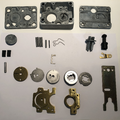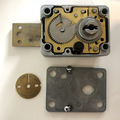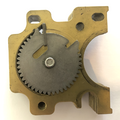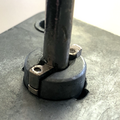Rosengrens RKL-10: Difference between revisions
m (added catregory:rosengrens) |
(principles of operation.) |
||
| Line 21: | Line 21: | ||
== Principles of operation == | == Principles of operation == | ||
This lock has a double circular lever one pack consisting of 9 code wheels and 2 driver wheels. The other pack engages with the cuts on the key, drives the code pack and a corresponding fence that will go into the true cuts and then allows the bolt to be moved into the open or closed positions. The key has 9 different cuts (1 passive cut called AB). Cuts 1-4 are on the A-side of the key. Cuts 5-8 are on the B-side of the key. No cut on side A is called A1. Deepest cut on side A is called AB. AB is a passive cut. An AB cut meant that the next active cut is B5-B8. There is a transport key which being a no-cut is all A1's. | |||
Only one side of the key is ever active in each cut position. Cuts on the opposite side of the key in these positions are only to make visual inspection harder. | |||
== Gallery == | == Gallery == | ||
Revision as of 15:50, 2 June 2024
Rosengrens RKL-10
| Rosengrens RKL-10 | |
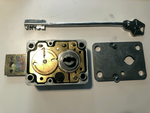 | |
| Name | Rosengrens RKL-10 |
|---|---|
| Manufacturer | Rosengrens |
| Lock Type | Safe lock |
| Lock Design | Disc-detainer |
| Specifications | |
| # of Components | 9 |
| Component Type | Disc-detainer |
Principles of operation
This lock has a double circular lever one pack consisting of 9 code wheels and 2 driver wheels. The other pack engages with the cuts on the key, drives the code pack and a corresponding fence that will go into the true cuts and then allows the bolt to be moved into the open or closed positions. The key has 9 different cuts (1 passive cut called AB). Cuts 1-4 are on the A-side of the key. Cuts 5-8 are on the B-side of the key. No cut on side A is called A1. Deepest cut on side A is called AB. AB is a passive cut. An AB cut meant that the next active cut is B5-B8. There is a transport key which being a no-cut is all A1's. Only one side of the key is ever active in each cut position. Cuts on the opposite side of the key in these positions are only to make visual inspection harder.
Gallery
Vulnerabilities
- Lockpicking
- Decoding
External links
- Ларин Олег (Larin Oleg) OB ROSENGRENS RKL10 (video)
- Idanhurja Operation of RKL10 demonstrated using a cutaway lock (video)
- Fey, Han. Abloy Special Products (Part 4)
See also
| This article is a stub. You can help Lockwiki by expanding it. |
